Preparing & showing Sensurround @ the Schauburg, 2010
With introductions by Wolfram
Hannemann, MBKS | Read more at
in70mm.com
The 70mm Newsletter
|
| Written by: Wolfram
Hannemann, MBKS, | Date:
07.06.2010 |
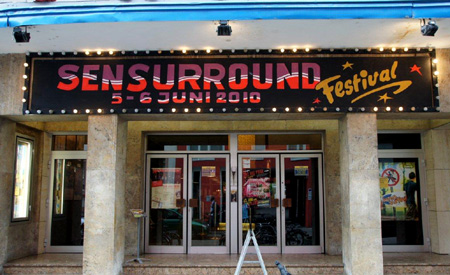 The
Schauburg Cinema dressed for SENSURROUND. Image by Herbert Born The
Schauburg Cinema dressed for SENSURROUND. Image by Herbert Born
Meine sehr geehrten Damen und Herren,
liebe Filmfreundinnen und – freunde,
im Namen des Schauburg Cinerama Theaters darf ich Sie ganz herzlich
willkommen heissen zum 3. Widescreen Weekend. Getreu unserem Motto “Alte
Kinotechnik frisch aufpoliert” widmen wir uns nach CinemaScope und
VistaVision an diesem Wochenende einem historischen Tonsystem, das in
den siebziger Jahren dafür sorgte, dass es in den Kinos richtig rumpelte:
Sensurround. Das von den Universal Studios patentierte Tonsystem kam nur
in fünf Filmen zum Einsatz und verschwand danach sang- und klanglos.
Unser kleines Festival präsentiert Ihnen alle fünf Filme, die allesamt
aus dem Hause Universal stammen, in chronologischer Reihenfolge und in
ihrer deutsch synchronisierten Fassung. Herbert Born und sein
Technikerteam haben jede Menge Arbeit und literweise Schweiß in dieses
weltweit einmalige Projekt gesteckt und ich bin mir absolut sicher, dass
sich der Aufwand gelohnt hat.
| More in 70mm reading:
Sensurround @ the Schauburg
“In Sensurround” 5-6 Juni 2010 - English
"Earthquake" at
the Schauburg
"Erdbeben" in der Schauburg
Internet link:
schauburg.de
|
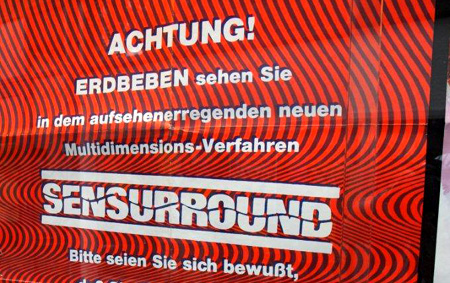 The
Schauburg Cinema dressed for SENSURROUND. Image by Herbert Born The
Schauburg Cinema dressed for SENSURROUND. Image by Herbert Born
Für alle die mich noch nicht kennen: mein Name ist Wolfram Hannemann.
Wenn ich nicht gerade in meiner Eigenschaft als Geschäftsführer eines
kleinen DVD-Versandhandels beschäftigt bin, arbeite ich als
freiberuflicher Filmkritiker. Wie schon in den Vorjahren so darf ich Sie
auch an diesem Wochenende wieder vor jedem der Filme mit einer kurzen
Einführung langweilen. Damit das interessanter wird und auch aus Respekt
für unsere nicht deutsch sprechenden Gäste gibt es auch jeweils einen
kurzen Teil in englischer Sprache.
| |
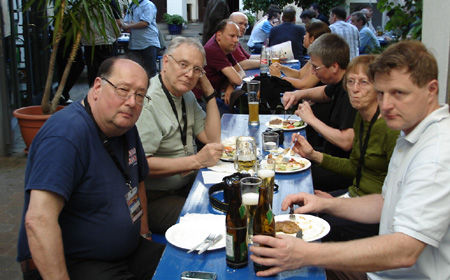 Francois
Carrin, Paul and Peggy Rayton and David Roussel. Image by
Wolfram Hannemann Francois
Carrin, Paul and Peggy Rayton and David Roussel. Image by
Wolfram Hannemann
Ladies
and Gentlemen,
hello film enthusiasts!
On behalf of the Schauburg Cinerama theatre I like to welcome you to the
third Widescreen Weekend. After having presented weekends dedicated to
CinemaScope and Vistavision in previous years, this weekend will be
fully devoted to Universal Studios‘ historic sound system Sensurround.
Herbert Born and his team of technicians have done their very best to
present the five films which were released with Sensurround here in
Germany the way they were intended to be shown. And please keep in mind
that this event is the only one of its kind worldwide! All prints will
be presented in their German dubbed versions without any subtitles in
English. If you don’t understand German, don’t worry. I am confident
that after listening to Sensurround you don’t mind what language the
film is in!
My name is Wolfram Hannemann and I have the pleasure to do introductions
before each film. As a little bonus for our foreign guests, I will do
parts of my intros in English. Well, at least I call it English although
you may find that it is sounding very German.
| |
 The
social aspect is important to the Widescreen Weekends at the Schauburg
Cinema. Image by Paul Rayton The
social aspect is important to the Widescreen Weekends at the Schauburg
Cinema. Image by Paul Rayton
Die ersten Pläne für einen epischen Katastrophenfilm mit dem Titel
ERDBEBEN wurden bereits 1971 bekanntgegeben. Mario Puzo sollte das
Drehbuch schreiben und John Sturges die Regie führen. Puzo lieferte zwei
Drehbuchentwürfe ab, bevor er durch George Fox ersetzt wurde. Der
wiederum entwarf gleich zehn Drehbücher, die allesamt vom Studio
abgelehnt wurden, bevor schließlich und endlich Mark Robson mit dem
endgültigen Drehbuch und auch mit der Regie beauftragt wurde. Aus
vertragsrechtlichen Gründen erhielt Robson allerdings keine Nennung als
Drehbuchautor. Mark Robson verbrachte Monate damit, den Film zusammen
mit seinen Ausstattern Alex Golitzen und Preston Ames vorzubereiten und
er umgab sich mit nicht weniger als gleich drei Special Effects Experten:
Frank Brendel, Glen Robinson und Jack McMasters.
| |
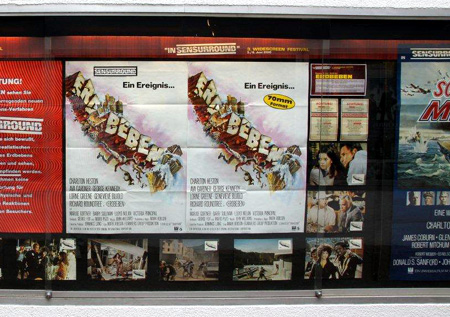 The
Schauburg Cinema dressed for SENSURROUND. Image by Herbert Born The
Schauburg Cinema dressed for SENSURROUND. Image by Herbert Born
Ihnen zur Seite stand
Matte Painting Guru Albert Whitlock, der Beste seines Fachs zu dieser
Zeit. Doch es war die Tonspur des Films, die sozusagen als das
Sahnehäubchen bei der Bewerbung des Films zum Tragen kam. Denn das neu
entwickelte und bei diesem Film erstmals eingesetzte “Sensurround”-Tonsystem
sollte dem Publikum hautnah das Gefühl vermitteln, wie es sich anfühlt,
bei einem Erbeben der Stärke 10 auf der Richterskala “live” dabei zu
sein. John Daheim, der als Stunt Coordinator bei Filmen wie SPARTACUS
oder DIE KANONEN VON NAVARONE mitarbeitete, hatte ein Heer von 141
Stuntfrauen und –männern zu betreuen. Trotz der vielen gefährlichen
Szenen, die zu filmen waren, gab es nur zwei Unfälle am Set. Zum einen
wurde ein Schauspieler während der Flutsequenz durch den Wasserdruck
gegen eine Wand gedrückt, zum anderen stürzte Bud Ekins, das Double für
Richard Roundtree, während des Motorrad-Stunts.
Dreharbeiten für den auf 7 Millionen US-Dollar budgetierten Film
begannen am 11. Februar 1974, just an dem Tag, an dem ein Erdbeben mit
einer Stärke von 3.5 die Universal-Studios erschütterte. Im November
desselben Jahres feierte ERDBEBEN in Los Angeles seine Premiere und
spielte in den Folgemonaten weltweit über 80 Millionen US-Dollar ein.
1975 erhielt der Film Oscars in den Kategorien “Bester Ton” und “Beste
optische Effekte”.
| |
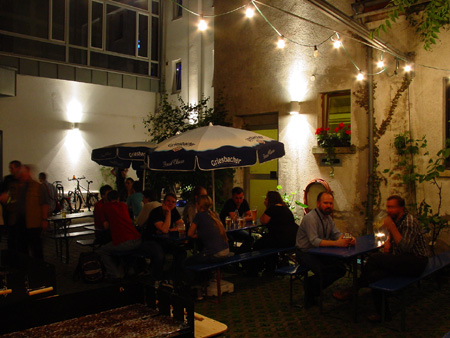 The
Schauburg SENSURROUND "Beer Garten". Image by Paul Rayton The
Schauburg SENSURROUND "Beer Garten". Image by Paul Rayton
EARTHQUAKE from 1974 was the first of a whole bunch of disaster movies
which were released at the beginning of the seventies. Disaster movies
not because they were so bad, but because their storyline centered
around a disaster. Directed by Mark Robson, scored by John Williams and
photographed by Phillip Lathrop in 35mm anamorphic Panavision,
EARTHQUAKE got the special 70mm blow up treatment for its initial run.
The print we are going to screen is a German dubbed 70mm print from its
premier run in Germany. Unfortunately the colors already faded up to a
certain level, but I am sure that the installed Sensurround system will
let you forget about that immediately once you felt it. Besides I
personally think that its faded look perfectly underlines the film’s
somewhat trashy character. The cast features Hollywood legends Charlton
Heston and Ava Gardner as well as Genevieve Bujold, Richard Roundtree
and Lorne Greene. And of course no disaster movie would be complete
without George Kennedy. But there is someone else: Walter
Matuschanskayasky who is playing a drunk is nobody less than Walter
Matthau appearing under a pseudonym. And we do have a reference to
another Hollywood legend in the film: Clint Eastwood, who just turned
80. Clips from his movie HIGH PLAINS DRIFTER appear on the screen inside
a movie theatre. And if you want to see the original script for
EARTHQUAKE just look out for the scene in which Charlton Heston is
running lines with Genevieve Bujold, for the script in his hands is the
actual script for that scene!
| |
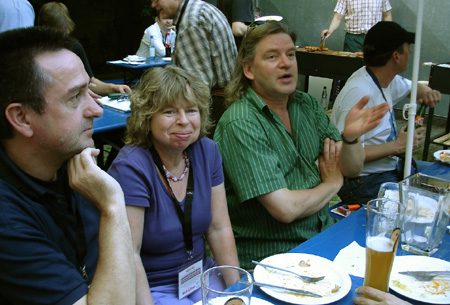 Herbert
Born in green shirt. Image by
Wolfram Hannemann Herbert
Born in green shirt. Image by
Wolfram Hannemann
When the movie played at Graumann's Chinese Theater in Hollywood in 1974
very soon after the preview performances, a giant net had to be rigged
above the patrons because of fear that the ornate ceiling decorations
might break loose and fall on the audience below due to the low bass
rumble of earthquake sequences. If you direct your eyes towards the
ceiling of this movie theatre you will find that there is no safety net
installed. So just put on your own safety helmet whenever you think you
need it.
Es freut mich Ihnen auch noch einen besonderen Gast ankündigen zu dürfen:
Herrn Randolf Schmidt, der zur “Sensurround”-Zeit Dubbing- und
Print-Manger bei CIC Deutschland war und Ihnen im Anschluss an den Film
gerne für eine Q&A Session zur Verfügung stehen wird. Ich bin mir sicher,
dass er uns eine ganze Menge zu Sensurround erzählen kann. Damit dafür
auch entsprechend Zeit vorhanden ist, werden wir ERDBEBEN entgegen
bisherigen Ankündigungen ohne Pause zeigen.
I am pleased to welcome Mr. Randolf Schmidt who used to work as Dubbing
and Print Manager for CIC in Germany during their Sensurround period.
Mr. Schmidt will be available for a Q&A session right after the
screening.
And now, ladies and gentlemen, let’s get ready for a real big rumble!
| |
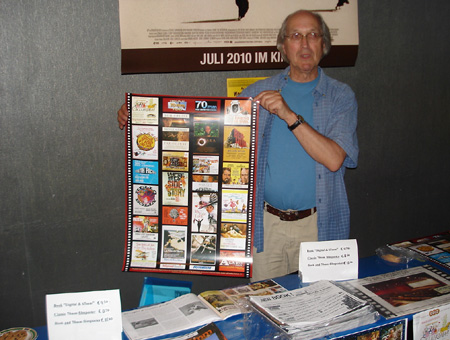 John
Wolthuis. Image by
Wolfram Hannemann John
Wolthuis. Image by
Wolfram Hannemann
Eineinhalb Jahre nach dem enormen Erfolg von ERDBEBEN brachte Universal
den zweiten Film in Sensurround in die Kinos. Kein Katastrophenfilm,
sondern ein Kriegsfilm sollte die Zuschauer dieses Mal mit seinem
leistungsstarken Tiefbass-Tonsystem mitten in das Geschehen holen. Die
SCHLACHT UM MIDWAY, jene entscheidende Seeschlacht im Juni des Jahres
1942, bei der die Japaner von den Amerikanern besiegt wurden, erschien
den Entscheidungsträgern bei Universal als bestens geeignet, das
Universal-eigene Tonsystem erneut einzusetzen. Dieses Mal natürlich
nicht zur Simulation eines Erdbebens, sondern um die Schrecken einer
Kriegsschlacht nachempfinden zu können. Dazu hätte es natürlich auch
einer entsprechenden stereophonischen Tonmischung bedurft, doch man
entschied sich bei Universal für eine Mono-Tonspur, die natürlich
wesentlich kostengünstiger war.
| |
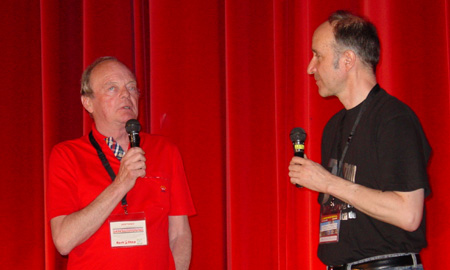 Wolfram
Hannemann interviewing Randolf Schmidt (former Dubbing & Print Manager
with CIC, Germany) on the Schauburg stage. Image by
Paul Rayton Wolfram
Hannemann interviewing Randolf Schmidt (former Dubbing & Print Manager
with CIC, Germany) on the Schauburg stage. Image by
Paul Rayton
Der 1925 in Minneapolis geborene Jack Smight wurde mit der Regie
beauftragt. Smight machte sich vor allem einen Namen beim Fernsehen, wo
er unter anderem Episoden der Serien BANACEK, MADIGAN oder McCLOUD
inszenierte. Vor SCHLACHT UM MIDWAY führte er bei dem Katastrophenfilm
AIRPORT 75 (deutscher Titel: GIGANTEN AM HIMMEL) Regie und arbeitete
hier bereits mit Charlton Heston zusammen, den er auch für MIDWAY vor
die Kamera holte. Smight starb 2003 im Alter von 77 Jahren in Los
Angeles. | |
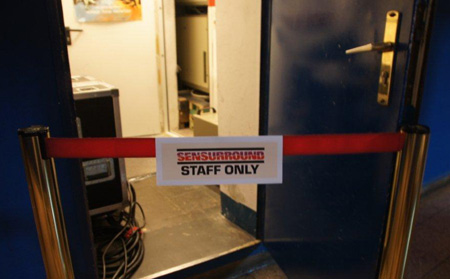 The
Schauburg projection room. Image by Herbert Born The
Schauburg projection room. Image by Herbert Born
Nicht nur Charlton Heston ist eine der Gemeinsamkeiten zwischen ERDBEBEN
und MIDWAY. Auch die Musik für beide Filme stammt aus der Feder ein und
desselben Mannes: Komponist John Williams. Bereits Anfang der siebziger
Jahre hatte Williams alle Hände voll zu tun, galt er damals bereits als
einer der talentiertesten Filmmusiker, was sein Score zu dem 1975 Oscar-prämierten
JAWS (DER WEISSE HAI) bewiesen hatte. Seinen richtig großen Durchbruch
erlebte er jedoch erst zwei Jahre nach MIDWAY, als er die Scores für
STAR WARS und CLOSE ENCOUNTERS OF THE THIRD KIND ablieferte.
| |
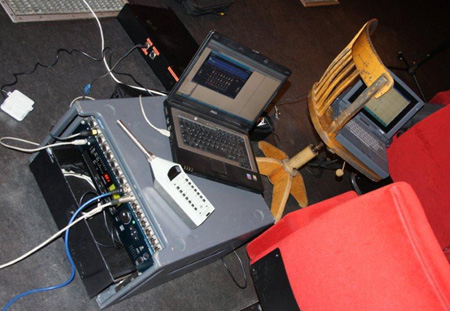 SENSURROUND.
Image by Herbert Born SENSURROUND.
Image by Herbert Born
Neben Charlton Heston spielen auch noch andere Hollywood-Haudegen wie
Henry Fonda, Glenn Ford, Robert Mitchum, Robert Wagner, Toshiru Mifune,
Cliff Robertson und Tom Sellek Hauptrollen in MIDWAY. In der Rolle des
japanischen Admirals Kusaka ist Pat Morita zu sehen, der den meisten von
uns als Mr. Miyagi aus dem 1984 entstandenen Film KARATE KID in
Erinnerung sein dürfte.
| |
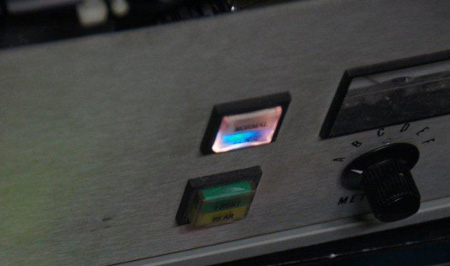 SENSURROUND
control box. Image by Herbert Born SENSURROUND
control box. Image by Herbert Born
MIDWAY from 1976 is based on true events that took place in June of 1942
in the Pacific Ocean during World War II and it was Universal’s second
plunge into Sensurround. No longer was their low frequency sound system
used to simulate earthquakes but to enhance battle sequences. Directed
by Jack Smight who replaced John Guillerman the film makes extensive use
of battle scenes from other movies. Most notable are the scenes from
20th Century Fox’s TORA! TORA! TORA! from 1970. But there are scenes
from AWAY ALL BOATS from 1956, THIRTY SECONDS OVER TOKYO from 1944 and
even from BATTLE OF BRITAIN from 1969 as well. Rumors say that Universal
tried to pass off some of the battle sequences as "newly discovered"
combat footage from WW II because they were not willing to pay for these
scenes. In addition newsreel footage from 1942 was used as well. This
footage had to be blown up with considerable cropping to fit into the
anamorphic Panavision frame in which MIDWAY was shot by Harry Stradling
Jr.
| |
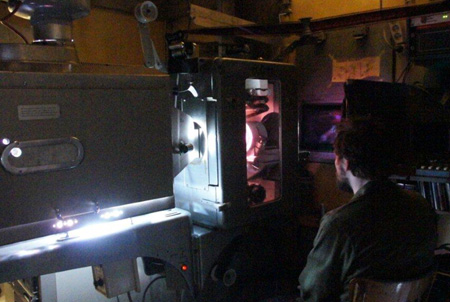 Marcus
Vetter projecting "Earthquake" in 70mm with SENSURROUND. Image by
Herbert Born Marcus
Vetter projecting "Earthquake" in 70mm with SENSURROUND. Image by
Herbert Born
The music for MIDWAY was composed by John Williams, who would later on
write the music for STAR WARS or CLOSE ENCOUNTERS OF THE THIRD KIND.
When MIDWAY was released in 1976 there was no accompanying soundtrack
album released. Only a 45rpm record containing the Main Theme and
another piece became available and thus made the score as one of the
most sought after among soundtrack collectors in the seventies. Luckily
in 1998 the complete score was released on CD with the Royal Scottish
National Orchestra conducted by Rick Wentworth.
So – let the battle begin!
| |
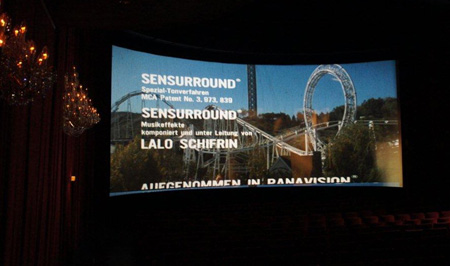 The
"Rollercoaster" SENSURROUND end titles. Image by Herbert Born The
"Rollercoaster" SENSURROUND end titles. Image by Herbert Born
ACHTERBAHN entstand im Jahre 1977 und war der dritte Film, in dem
Universal sein patentiertes Sensurround-Tonsystem zum Einsatz brachte.
Dieses Mal wollte man dem Kinozuschauer die rasanten Achterbahnfahrten
hautnah vermitteln. Wenn es um Achterbahnen geht, so werden vermutlich
die meisten der Anwesenden automatisch an die berühmte Eröffnungsszene
des ersten Cinerama-Films THIS IS CINERAMA! denken. Nicht auszudenken,
wenn Lowell Thomas und seine Techniker das Sensurround-Tiefbass-System
bereits 1952 zur Verfügung gehabt hätten!
| |
 SENSURROUND
control box in action. Image by Herbert Born SENSURROUND
control box in action. Image by Herbert Born
Aber zurück zu unserem Film. James Gladstone, der ein Jahr zuvor, also
1976, bereits den Piratenfilm SWASHBUCKLER (DER SCHARLACHROTE PIRAT) für
Universal inszenierte, übernahm die Regie bei ACHTERBAHN. Richard
Levinson und William Link, die schon 1975 gemeinsam bei DIE HINDENBURG
mitarbeiteten, übernahmen das Drehbuch, das nach einer Geschichte des
ehemaligen Kinderstars Tommy Cook entstand. David M. Walsh fungierte als
Chefkameramann des in Panavision photographierten Films. In den
Hauptrollen sind George Segal, Henry Fonda, Richard Widmark und Timothy
Bottoms zu sehen. Aber wie so oft bei älteren Filmen verdienen auch hier
die Nebenrollen Beachtung. So spielt die damals noch gänzlich unbekannte
und zu jener Zeit erst 14 Jahre alte Helen Hunt George Segals kleine
Tochter. Ferner begegnen wir Craig Wasson, der erst mit dem 1984
enstandenen Brian De Palma Thriller BODY DOUBLE einem breiteren Publikum
bekannt wurde. In ACHTERBAHN darf er einen Hippie spielen. Und last but
not least war es die erste Filmrolle für Steve Guttenberg. Seine Rolle
als Laufjunge ist allerdings so klein, dass er weder im Vor- noch
Abspann genannt wird.
| |
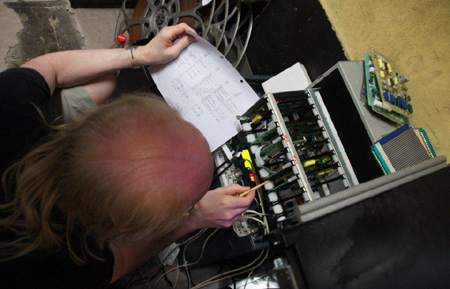 Last
minute adjustments by Schauburgs Sound master Technicians (SSMT) Gunter Oehme for SENSURROUND. Image by Herbert
Born Last
minute adjustments by Schauburgs Sound master Technicians (SSMT) Gunter Oehme for SENSURROUND. Image by Herbert
Born
ROLLERCOASTER premiered in 1977 and was the
third movie enhanced by Universal’s Sensurround sound system. Before it
was released it had to undergo test screenings which resulted in severe
cuts being made afterwards. Obviousely some of the gory details were
just too much for audiences back in the seventies.
If you love rollercoasters then let me tell you that the film used
several real roller coasters and was shot on location at several
amusement parks. These include the Rebel Yell at Kings Dominion, the
demolished Rocket at Ocean View Amusement Park in Norfolk, Virginia and
Revolution at Six Flags Magic Mountain, Valencia, California. The latter
opened in 1976 and was the first roller coaster to feature a complete
360-degree vertical loop
| |
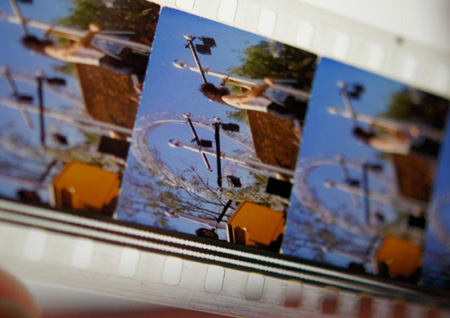 Anamorphic
"Rollercoaster" in Technicolor and SENSURROUND. Image by Herbert Born Anamorphic
"Rollercoaster" in Technicolor and SENSURROUND. Image by Herbert Born
The movie features an appearance by the band Sparks for the roller
coaster's opening concert, playing the songs "Fill 'Er Up" and "Big Boy"
from their 1975 album Big Beat. This role was rumored to have been
offered to Kiss who turned down the part. Sparks later cited their
appearance in the movie in answer to a question about the biggest regret
of their career. The background score for ROLLERCOASTER was composed by
Lalo Schifrin, who became world famous with his main theme for the
television series MISSION: IMPOSSIBLE. By the way: the same year he
scored ROLLERCOASTER Schifrin received an Academy Award nomination for
“Best Score” for his music for the 1976 VOYAGE OF THE DAMNED.
It is very interesting to note that matte painting specialist Albert
Whitlock did the visual effects for this film, but his name does not
appear in the credits.
So just sit back, relax and enjoy this thrill ride!
| |
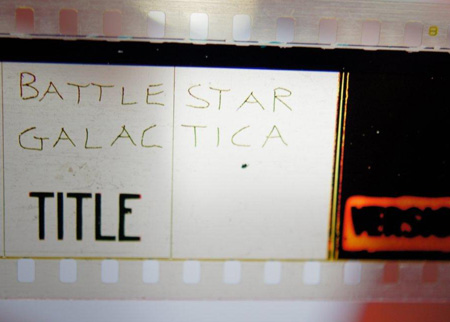 "Battlestar"
35mm leader. Image by Herbert Born "Battlestar"
35mm leader. Image by Herbert Born
Mit den letzten beiden Filmen unserer Sensurround-Reihe wagen wir uns in
die Untiefen einer Fernsehproduktion, die es Dank ihres für damalige
Verhältnisse gigantischen Budgets sogar ins Kino schaffte. Auf diese Art
und Weise wollte Universal die hohen Produktionskosten wieder einfahren,
konnte man doch KAMPFSTERN GALACTICA werbetechnisch optimal im
Windschatten von STAR WARS auswerten, der nur ein paar Monate zuvor mit
einem sensationellen Erfolg gestartet war. Das allerdings ging der 20th
Century Fox zu weit und es kam zu einer Klage gegen Universal, in der
das Studio des Ideenklaus bezichtigt wurde.
| |
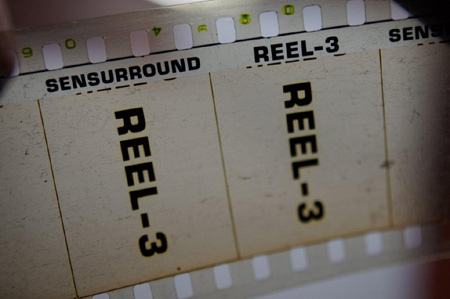 In
SENSURROUND. Image by Herbert Born In
SENSURROUND. Image by Herbert Born
Die Klage trug allerdings
keine Früchte, denn Universal ihrerseits bezichtigte 20th Century Fox
ebenfalls des Ideenklaus. Das Ganze verlief im Sande. Nichtsdestotrotz
sind die Ähnlichkeiten zwischen BATTLESTAR GALACTICA und STAR WARS nicht
zu übersehen. Das liegt vor allem natürlich daran, dass bei beiden
Filmen dieselbe Special Effects Mannschaft engagiert wurde: John
Dykstra, Dennis Muren, Richard Edlund. Und denkt man nicht bei Stu
Phillips‘ Titelmusik automatisch an John Williams‘ Eröffnungsfanfare aus
KRIEG DER STERNE?
Um die tontechnische Konkurrenz durch STAR WARS etwas abzumildern, der
in führenden Kinos damals natürlich mit 70mm Kopien und bombastischem
6-Kanal Dolby Stereo Magnetton präsentiert wurde, stattete Universal die
beiden KAMPFSTERN GALACTICA-Filme mit Sensurround aus. Es waren jedoch
auch die letzten beiden Filme, die mit diesem Tonsystem präsentiert
wurden.
| |
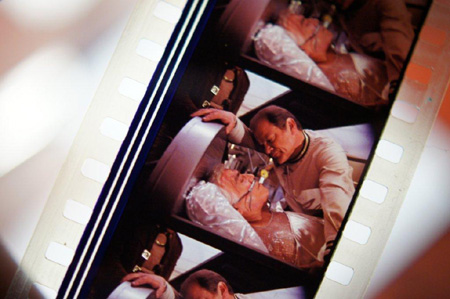 Eastman
color 35mm print of "battlestar Galactica". Image by Herbert Born Eastman
color 35mm print of "battlestar Galactica". Image by Herbert Born
Although lasting only for one season from 1978 to 1979, Universal’s
BATTLESTAR GALACTICA has since developed a cult following. Several books
have been written continuing the sagas of the characters. After its
cancellation, its story was continued in 1980 under the title GALACTICA
1980. A reboot series BATTLESTAR GALACTICA premiered in 2004.
| |
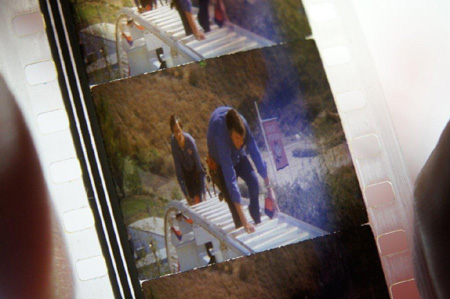 Anamorphic
"Rollercoaster" in Technicolor and SENSURROUND. Image by Herbert Born Anamorphic
"Rollercoaster" in Technicolor and SENSURROUND. Image by Herbert Born
Although produced for television, originally as part of a planned series
of telemovies and eventually as a television series, Universal Studios
decided to release a 125-minute version of the pilot film in cinemas in
order to recoup some of the high production costs with producers
believing the series "could be a fine shot at a corner of the STAR WARS
market." With 7 million US Dollars it was the biggest budgeted pilot
ever up to that time. In July 1978, two months before its U.S.
television debut, the film was released theatrically in Canada,
Australia, and some countries in Europe and Latin America. The release
was a success following an aggressive marketing campaign from Universal
and influenced the decision to release the BUCK ROGERS IN THE 25TH
CENTURY pilot in cinemas a year later. On September 17, 1978, the uncut
148-minute pilot premiered on ABC to spectacular Nielsen ratings and in
May 1979, the theatrical version was also released in the U.S. Later
episodes of the regular BATTLESTAR GALACTICA series were also re-edited
and released in cinemas internationally. So the two episodes "The Living
Legend" and "Fire in Space" were edited together to seem like one story
and released as BATTLERSTAR GALACTICA: THE CYLON ATTACK, which will be
screened as the final film in our Sensurround festival.
| |
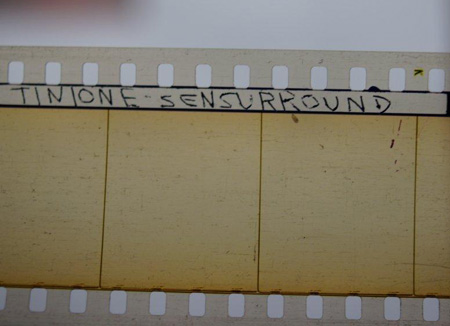 in
SENSURROUND. Image by Herbert Born in
SENSURROUND. Image by Herbert Born
In 1978, 20th Century Fox sued Universal Studios for plagiarism,
claiming it had stolen 34 distinct ideas from STAR WARS. Universal
promptly countersued, claiming STAR WARS had stolen ideas from their
1972 film SILENT RUNNING (notably the robot "drones") and the BUCK
ROGERS serials of the 1930s. Although GALACTICA was indeed created to
capitalize on the popularity of STAR WARS and used the same special
effects team and the same concept designer, both lawsuits were
eventually dismissed in 1980 as being "without merit".
Und damit wünsche ich uns jetzt spannende und vor allem kultige
Unterhaltung mit den beiden KAMPSTERN GALACTICA-Filmen! Ladies and
Gentlemen, please enjoy the final two films of our festival with earth
shattering Sensurround sound.
| |
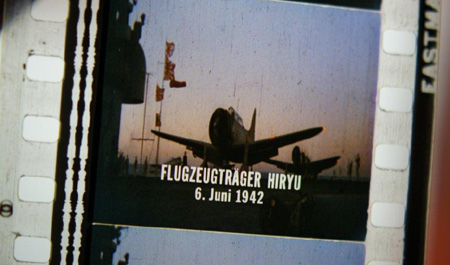 Anamorphic
"Midway" Technicolor print for SENSURROUND. Image by Herbert Born Anamorphic
"Midway" Technicolor print for SENSURROUND. Image by Herbert Born
| |
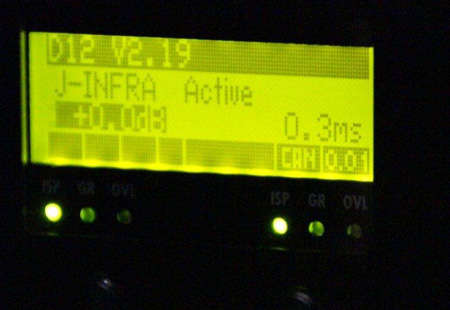 The
Schauburg in SENSURROUND. Image by Herbert Born The
Schauburg in SENSURROUND. Image by Herbert Born
| |
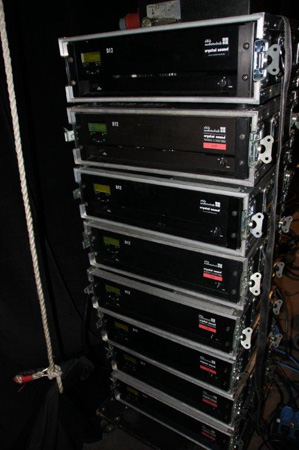 The
Schauburg's amplifiers for SENSURROUND. Image by Herbert Born The
Schauburg's amplifiers for SENSURROUND. Image by Herbert Born
| |
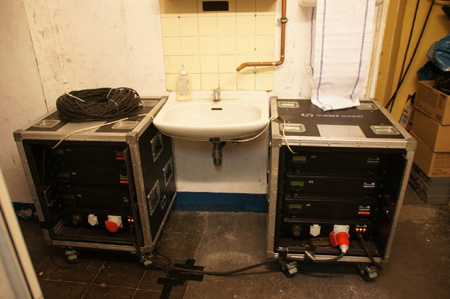 More
amplifiers for the Schauburg's SENSURROUND event. Image by Herbert Born More
amplifiers for the Schauburg's SENSURROUND event. Image by Herbert Born
| |
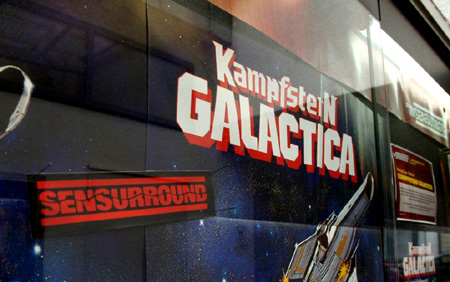 The
Schauburg Cinema dressed for SENSURROUND. Image by Herbert Born The
Schauburg Cinema dressed for SENSURROUND. Image by Herbert Born
| |
 The
Schauburg Cinema dressed for SENSURROUND. Image by Herbert Born The
Schauburg Cinema dressed for SENSURROUND. Image by Herbert Born
| |
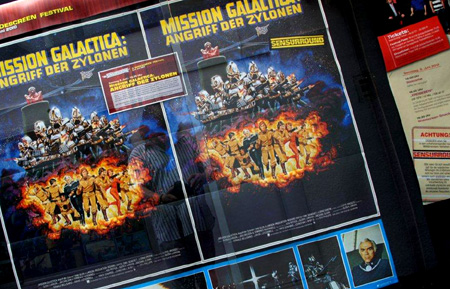 The
Schauburg Cinema dressed for SENSURROUND. Image by Herbert Born The
Schauburg Cinema dressed for SENSURROUND. Image by Herbert Born
| |
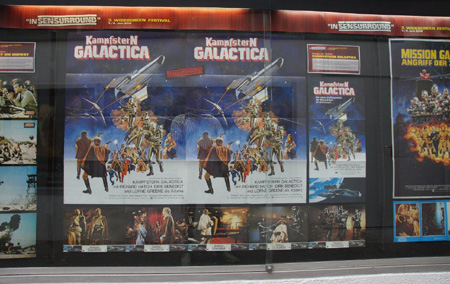 The
Schauburg Cinema dressed for SENSURROUND. Image by Herbert Born The
Schauburg Cinema dressed for SENSURROUND. Image by Herbert Born
| |
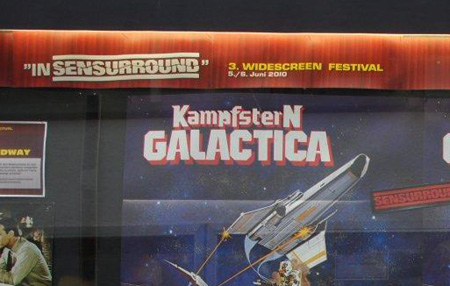 The
Schauburg Cinema dressed for SENSURROUND. Image by Herbert Born The
Schauburg Cinema dressed for SENSURROUND. Image by Herbert Born
| |
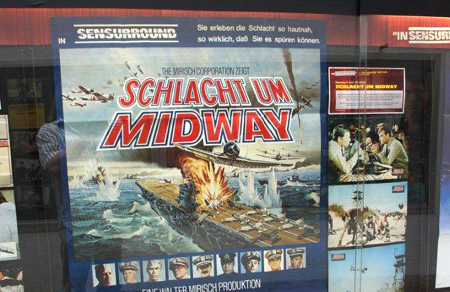 The
Schauburg Cinema dressed for SENSURROUND. Image by Herbert Born The
Schauburg Cinema dressed for SENSURROUND. Image by Herbert Born
| |
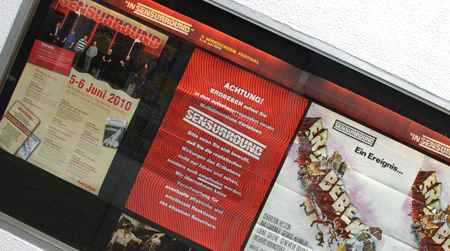 The
Schauburg Cinema dressed for SENSURROUND. Image by Herbert Born The
Schauburg Cinema dressed for SENSURROUND. Image by Herbert Born
| |
 Click image to
go to festival page Click image to
go to festival page
| |
|
| |
| | |
Go: back - top - back issues - news index
Updated
21-01-2024 | |